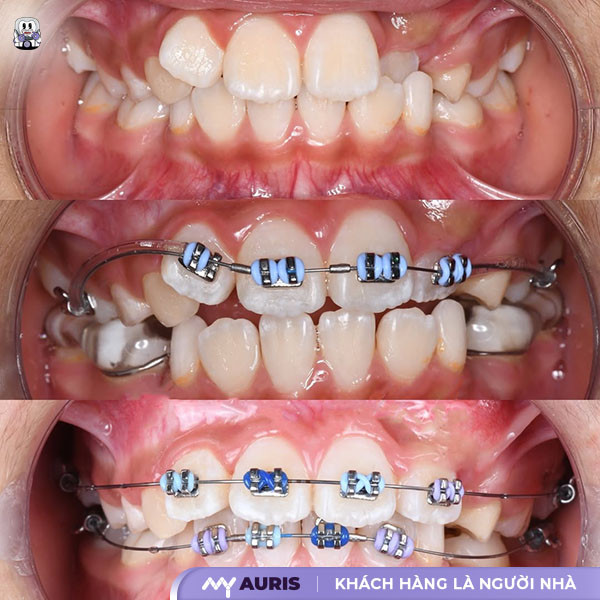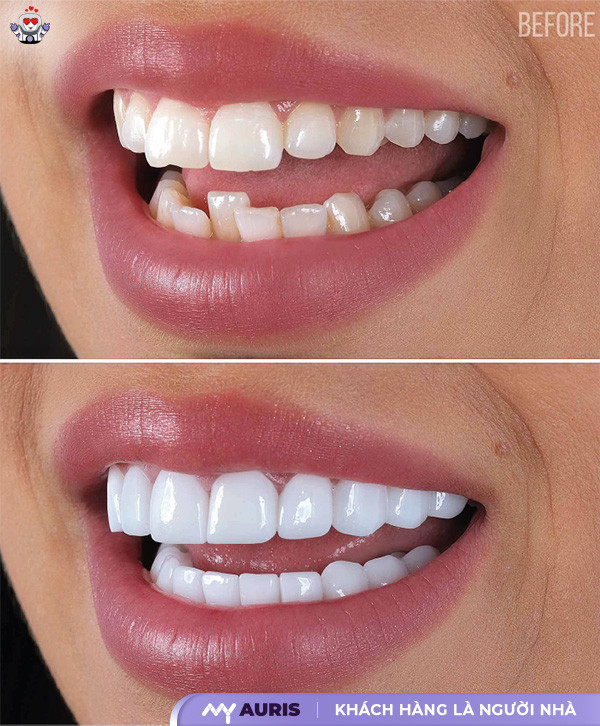The remarkable advancements in modern dental technology have brought many advanced treatment methods for oral problems, especially the condition of crowded teeth – a common issue affecting aesthetics and health. However, many people are still confused when choosing the most effective and suitable solution.
In this article, we will join you in exploring in detail about crowded teeth, their causes, and the modern dental treatment methods currently being applied. Let’s discover optimal solutions to achieve a beautiful, even smile, enhance your quality of life, and feel confident with your smile every day.
What are Crowded/Crooked Teeth? Are They Dangerous?
Crowded teeth refer to a condition where teeth in the jaw are not aligned properly on the dental arch. Instead of being evenly arranged according to a standard bite, teeth may be crowded, rotated, protrude outwards, or be pushed inwards. This is a common form of malocclusion, often found in both children and adults.
There are three common degrees of crowded teeth: mild (slight crowding, minor misalignment), moderate (rotated teeth, significant crowding), and severe (serious bite misalignment, entire jaw displacement). Accurately determining the degree of misalignment requires the support of an orthodontist and modern diagnostic tools such as CT Cone Beam X-rays.
Many people think that misaligned teeth only affect appearance. But in reality, the consequences of crowded teeth are more far-reaching:
Difficult to clean and prone to dental diseases: Crowded teeth create small gaps that are hard to clean. Long-term bacterial accumulation can lead to cavities, gingivitis, and periodontitis. Additionally, ineffective brushing can damage tooth enamel and affect the tooth pulp.
Causes malocclusion, affecting chewing function: When teeth are not in their correct positions, the standard bite is disrupted. This leads to unbalanced chewing, easily causing jaw muscle fatigue, headaches, and even jaw displacement if not treated promptly.
Impacts pronunciation and facial aesthetics: Incisors erupting in the wrong position can affect the pronunciation of sounds like “s”, “ch”, “x”. Furthermore, an uneven set of teeth can make the face appear asymmetrical, easily causing patients to lack confidence in communication.
Affects facial bone development (in young children): In children, if crowded teeth are not corrected early, they can alter the growth direction of the craniofacial bone system. This increases the risk of needing orthodontic surgery in adulthood.
Increased treatment costs if left untreated: The longer it’s left, the more severe the misalignment becomes. In such cases, treatment methods like braces or Invisalign will take longer, cost more, and the restorative results will also be less stable.

Causes of Crooked, Crowded Teeth
This condition can stem from various causes, including congenital factors, deviations during tooth development, or impacts from daily habits. For effective treatment, it’s crucial to understand the specific cause of this misalignment.
Genetic and Congenital Factors
One common cause is genetic factors. If parents have narrow dental arches, crowded teeth, or a misaligned bite, their children are at a high risk of experiencing similar conditions. Inherited craniofacial bone structure can result in teeth not having enough space to erupt evenly, leading to misalignment or rotation. In many cases, orthodontists need to assess the overall structure of the upper and lower dental arches using CT Cone Beam scans for clear determination.
Premature Loss of Baby Teeth or Prolonged Retention of Baby Teeth
Baby teeth play a role in holding space for permanent teeth. If baby teeth are lost too early or remain for too long past the age of tooth replacement, the dental arch will be affected. In such cases, permanent teeth may erupt in the wrong direction, become crowded, impacted, or result in malocclusion. This is a common cause seen in children whose tooth eruption process is not closely monitored.
Improper Wisdom Tooth Eruption
When wisdom teeth (third molars) erupt improperly, they can exert significant pressure on adjacent molars, causing the entire dental arch to shift. This is particularly common in individuals with small dental arches or weak periodontal systems. In such cases, dentists often recommend extracting wisdom teeth before proceeding with orthodontic treatment.
Bad Habits from Childhood
Habits such as thumb-sucking, prolonged pacifier use, tongue thrusting while swallowing, or nighttime teeth grinding can cause malocclusion and directly affect the direction of tooth eruption. If not addressed early, these habits will lead to maloccluded teeth, resulting in a misaligned and hard-to-control dentition.
Insufficient Space in the Dental Arch for Tooth Eruption
Another common cause is a narrow or unevenly developed dental arch. When there isn’t enough space in the arch, teeth are forced to crowd together to erupt. This leads to crowded, rotated, or misplaced teeth. In such cases, orthodontists often treat with traditional braces or clear aligners like Invisalign, combined with palate expansion if necessary.
Current Methods for Correcting Crowded Teeth
In most cases, if teeth are severely misaligned, have an underbite, or exhibit comprehensive malocclusion, braces remain the most effective solution. However, if the misalignment is minor and doesn’t affect the bite, patients may consider porcelain crowns or veneers to save time while still improving their appearance. Below are three commonly applied methods.
Orthodontic Braces – Comprehensive Intervention
Orthodontic braces are a solution for realigning underlying tooth structures, comprehensively correcting the standard bite, and guiding teeth to their ideal positions on the dental arch. This method is suitable for severe misalignments, significant crowding, overbites/underbites, rotated teeth, or deep bites.
The average treatment time ranges from 12 to 24 months. Fixed braces are the most common type, but many people now choose clear aligners like Invisalign for enhanced aesthetics. This method requires a dentist with high expertise and experience in dentofacial orthodontics to achieve optimal results.

Cosmetic Porcelain Crowns – Suitable for Mild Misalignment
Porcelain crowns are a method of reshaping teeth by grinding down a portion of the natural tooth structure and placing a porcelain crown over it. This is suitable for cases of mild tooth misalignment, slightly crowded front teeth, or gaps that require creating a standard bite.
There are various types of porcelain, such as zirconia, Emax, and metal-ceramic. Each type has different durability and aesthetic qualities, affecting treatment costs. Porcelain crowns are not suitable for individuals with significant malocclusion because they cannot correct the underlying tooth position, nor can they improve the tooth’s eruption axis like braces.
Nevertheless, if teeth are fundamentally even and only slightly misaligned, porcelain crowns can quickly improve oral aesthetics in just 5–7 days. The average durability of porcelain crowns ranges from 10 to 20 years with proper care.
Porcelain Veneers for Mildly Uneven Teeth
Porcelain veneer bonding is an ultra-thin (0.3–0.5 mm) dental restoration technique that involves only filing the outer surface of the tooth and bonding a layer of porcelain onto it. It is suitable for cases of slightly misaligned teeth, uneven tooth shapes, unattractive color, worn enamel, or slightly gapped front teeth.
A major advantage of this method is that it preserves the maximum amount of natural tooth structure, does not cause prolonged sensitivity, and has a short treatment time (approximately 3–5 days). However, veneers are only effective for mild misalignments and cannot address bite issues or incorrect tooth axes.
Choosing veneers requires the patient to have a fairly balanced set of teeth, no jaw arch misalignment, and no teeth grinding habit. The lifespan of veneers ranges from 8 to 15 years with good care. They are often applied in cosmetic cases involving front teeth.

Can Crooked Teeth Be Treated with Porcelain Crowns?
To answer the question of whether crooked teeth can be treated with porcelain crowns, it’s necessary to consider the degree of misalignment, the position of the crooked teeth, and the overall bite. If the teeth are only slightly crooked, not affecting the bite or the structure of the periodontal system, porcelain crowns can be a quick and aesthetically effective solution.
However, if teeth are severely crooked, have a deep bite, underbite, or severe crowding, porcelain crowns are not the optimal choice. In such cases, an orthodontist will recommend braces first to establish a standard dental arch foundation, and then consider cosmetic porcelain crowns if necessary.
The diagnostic process requires 3D X-rays or CT Cone Beam scans to accurately assess the upper dental arch, lower dental arch, and the degree of tooth axis deviation. For those seeking rapid aesthetic improvement and who prefer not to wear braces, porcelain crowns can be applied if suitable conditions are met.
Notes for Treating Crowded Teeth to Achieve Long-Term Effectiveness
Below are important notes to help you proactively care for and maintain treatment results after undergoing braces, porcelain crowns, or other cosmetic restoration methods.
After treating crowded teeth, you need to maintain good oral hygiene to prevent gingivitis, cavities, or enamel damage. Use a soft-bristled toothbrush, a water flosser, and interdental cleaning tools for effective cleaning. If you have just had braces removed, wear your retainers as prescribed by your dentist to prevent teeth from shifting back to their original positions. Those with porcelain crowns should avoid chewing hard foods and limit colored foods to maintain the long-term durability and color of ultra-thin porcelain veneers.
Even after completing treatment, you still need to visit the dentist every 6 months to check your bite and the stability of your teeth. Some cases, such as rotated teeth, impacted teeth, or teeth pressing on gums, are at risk of relapse if not closely monitored. The dentist may prescribe minor adjustments or replace retention appliances if abnormalities are detected in the craniofacial bone structure or shifts in the upper or lower dental arches.
The effectiveness of treatment depends not only on the method but also on the dentist’s expertise and the quality of equipment. Choose a dental clinic with a team of highly trained orthodontists experienced in treating crowded teeth from mild to severe cases.





